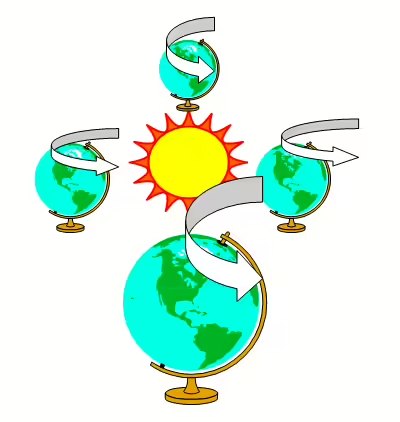Sun
Sunrise, sunset: It's a journey.
This activity will show how these factors cause the position of the sun in the sky to change, particularly at sunrise and sunset.
There are three things that changes the sun's position in the sky.
- The first is the earth's spin (rotation). It takes 24 hours for the earth to make one complete rotation.
- Another is the earths travel (revolution) around the sun. It takes approximately one year for the earth to make one revolution around the sun.
- The third is the fact that the earth's rotation is tilted approximately 23 1/2 degrees from vertical. It is because of this that we have seasons.
Materials: A globe (one that is tilted), flashlight, notepaper, and pencil.
Earth's Rotation Activity:
- Have a friend or helper pretend to be the sun by standing with the flashlight.
- With the globe several feet away from the flashlight, spin the globe so that the top is spinning counter-clockwise.
- Shining the flashlight on the globe, note how the light is more direct around the equator, and less direct around the poles.
- Move in a slow circle around the "sun," stopping once in awhile to see how the light hits the earth differently as you go around. Make sure the tilting of the earth does not change as you circle around the sun, using the diagram as a guide.
- Look at North America.
- How does the revolution of the earth around the sun change the amount of light it receives?
- Stopping in one position while still spinning the globe, try to imagine what position on the horizon the sun would be when sunrise and sunset occurs.
- Now move to another position in the circle. Would sunrise and sunset still be in the same place?
Over the next month: Find a location you can observe the sunrise or sunset. Once a week, standing in the same location, observe the position of sunrise or sunset. Caution: Do not stare at the sun. Note the change in the position of the sun on the horizon.
Observations: Depending on the time of year, you should see the sun heading north (December 21 to June 21) or south (June21 to December 21). On March 21 and September 21, the sun should rise due east and set due west.
- Make a picture collage of the changes. e sure to show the dates when the pictures were taken and try to include some landmarks in the pictures to add perspective.
Reflect on these questions:
- How does the tilt of the earths axis affect the amount of sunlight North America receives?
- If the earth's axis was not tilted, would we still have seasons? (Hint: Try making the globe spin vertically, and move it around the flashlight "sun.")
- Do people in North America ever see the sun directly overhead at noon?
Dig Deeper: Watch what causes the seasons. Bonus lesson: Watch how the sun heats the earth.
